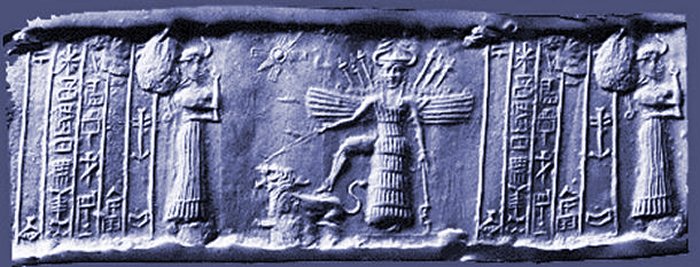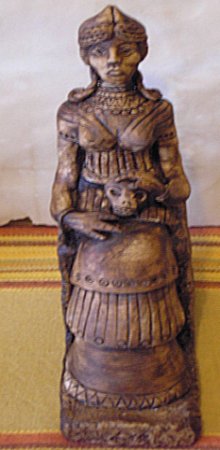Ereshkigal – Ruler Of The Sumerian Underworld And Most Feared Deity In Mesopotamian Pantheon
A. Sutherland - AncientPages.com - Ereshkigal, a granddaughter of Enlil, is the queen of the underworld or Irkalla ( the land of the dead). She is older sister of Inanna (later known as Ishtar) and wife of Nergal, the king of death who brings disease, plague, and all misfortunes caused by heat.
Ereshkigal, whose name means "Queen of the Great Below", is very powerful ruler in her kingdom of the dead and her judgment and laws are always indisputable.
Ereshkigal Was Given The Underworld For Her Domain
In Sumerian religion, in the very beginning, the universe was divided into three regions each of which became the domain of a god. Anu, Sky Father, was also "King of the Gods", "Lord of the Constellations, Spirits and Demons", and "Supreme Ruler of the Kingdom of Heaven", which was his domain. The earth was given to Enlil. Ea became the ruler of the waters.
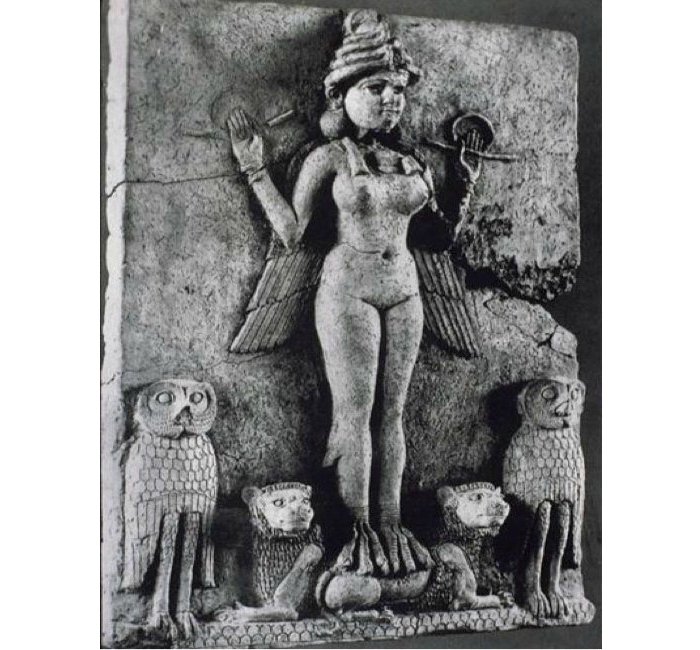
Ishtar/Inanna) or possibly female demon Lilith, attended by owls and lions. 2025-1763 BC, terracotta relief panel, Credits: ARTstor, http://library.artstor.org
Together they constituted the triad of the Great Gods.
According to the Epic of Gilgamesh (c.1850 BC), Ereshkigal was “given the underworld for her domain” and she became the ruler of the Underworld.
However, in another story (similar to that of Ovid’s tale of Hades’ and abduction of the goddess Persephone), Ereshkigal is kidnapped by her half-brother, the dragon Kur, and taken to the underworld where she is made queen.
Inanna Descends To Gloomy Kingdom Of The Dead
No one could ever question her decisions and those who enter her world can no longer return to the world of the living.
The Kingdom of Ereshkigal is a gloomy land of shadows, with no future and no hope. To this abyss of hopelessness are thrown not only sinners but also good and bad, great and small, God-fearing people and blasphemers. All of them become powerless and pale forever.
See also:
Mighty Enlil Of The Sumerian Pantheon Of Gods
Ur-Nammu – Popular And Accomplished Ruler Of Sumer
Sumerian 'Mask Of Warka' From Uruk: Sculptured Face May Depict Goddess Inanna
Uruk: The First City Built By King Gilgamesh 4,500 Years Ago
The exception is Inanna, the goddess of life and fertility, whose descent to Ereshkigal’s underworld is believed to be one of the most known Sumerian myths. Inanna and Ereshkigal have never been good friends. Moreover, Inanna enters the underworld in an unsuccessful attempt to deceitfully take power over the abyss of Ereshkigal.
She is punished by her and killed and her corpse hangs on a hook. It seems that even gods who try to convince Ereshkigal to release Inanna, are powerless to help, because in the underworld, there are rules and principles, which have to be followed.
Finally Ereshkigal gives Inanna’s corpse to the gods, and they revive the goddess with water of life and food. Inanna ascends to the upper world, but must send someone down to take her place in the land of the dead.
She decides to send her husband, Dumuzi as the substitution because Dumuzi is the one who has not mourned her death.
Appearance of Ereshkigal is not exactly known.
The Akkadians associated her with their own Semitic underworld goddess, Allatum. There is, however, a rectangular, fired clay relief panel depicting a naked woman standing on two lions and flanked by owls, holding a rod and ring in her hands.
These two symbols are often depicted on Mesopotamian stelas, cylinder seals and reliefs.
Whether this panel depicts Inanna or Ereshkigal is still under debate. It has even been proposed that it may represent female demon Lilith.
With few exceptions, Ereshkigal had no cult center in Mesopotamia and as a result, she is only occasionally encountered outside the literature. Inscriptions confirm that temples dedicated to her existed in Kutha, Assur and Umma.
Her coalition government with Nergal begins in the old-Babylonian period (1830 - 1531 BC). During the first millennium BC, Nebuchadnezzar II - a Chaldean king of the Neo-Babylonian Empire, who reigned c. 605 BCE – c. 562 BC - rebuilt her temple in Kutha (Cuthah).
Written by – A. Sutherland AncientPages.com Staff Writer
Copyright © AncientPages.com All rights reserved. This material may not be published, broadcast, rewritten or redistributed in whole or part without the express written permission of AncientPages.com
Expand for referencesReferences:
Cotterell & R. Storm, The Ultimate Encyclopedia of Mythology
McIntosh, Ancient Mesopotamia: New Perspectives
More From Ancient Pages
-
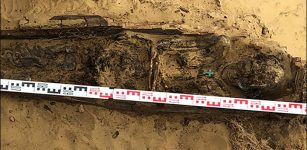 Mysterious Mummified Woman With A Christian Cross On Her Chest Dashes Hopes Of Finding First Russian Fortress In Yakutia
Archaeology | Dec 12, 2019
Mysterious Mummified Woman With A Christian Cross On Her Chest Dashes Hopes Of Finding First Russian Fortress In Yakutia
Archaeology | Dec 12, 2019 -
 What Happened To The Ancient Tribe That Entered A Secret Underground World And Never Came Back?
Featured Stories | Feb 1, 2021
What Happened To The Ancient Tribe That Entered A Secret Underground World And Never Came Back?
Featured Stories | Feb 1, 2021 -
 Monster Water God Gong Gong Blamed For Cosmic Catastrophes In Chinese Myths
Chinese Mythology | Nov 2, 2020
Monster Water God Gong Gong Blamed For Cosmic Catastrophes In Chinese Myths
Chinese Mythology | Nov 2, 2020 -
 Massive Eruption Of Iceland’s Laki Volcano Triggered An Unusually Cold Winter In 1783-84
Archaeology | May 21, 2019
Massive Eruption Of Iceland’s Laki Volcano Triggered An Unusually Cold Winter In 1783-84
Archaeology | May 21, 2019 -
 New Study: Fossils Reveal Human Ancestors’ Hearing Abilities
Human Beginnings | Sep 28, 2015
New Study: Fossils Reveal Human Ancestors’ Hearing Abilities
Human Beginnings | Sep 28, 2015 -
 65 Byzantine-Era Tombs Unearthed In Stratonikeia – World’s Largest Marble City
Archaeology | Feb 24, 2017
65 Byzantine-Era Tombs Unearthed In Stratonikeia – World’s Largest Marble City
Archaeology | Feb 24, 2017 -
 Koshchey ‘The Immortal’: Strong And Wise Ruler Of Darkness In Slavic Mythology
Featured Stories | Jul 3, 2016
Koshchey ‘The Immortal’: Strong And Wise Ruler Of Darkness In Slavic Mythology
Featured Stories | Jul 3, 2016 -
 This Lunar Year Will Be The Year Of The Rabbit Or The Year Of The Cat, Depending On Where You Live
Ancient Traditions And Customs | Jan 23, 2023
This Lunar Year Will Be The Year Of The Rabbit Or The Year Of The Cat, Depending On Where You Live
Ancient Traditions And Customs | Jan 23, 2023 -
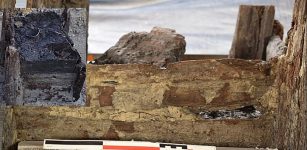 Czech Neolithic Well Is Oldest Wooden Structure In The World
Archaeology | Mar 11, 2020
Czech Neolithic Well Is Oldest Wooden Structure In The World
Archaeology | Mar 11, 2020 -
 Amaterasu: Shinto Goddess Of The Sun And Priestess-Queen Sister To Controversial Susanoo God Of Storms
Featured Stories | Jan 25, 2019
Amaterasu: Shinto Goddess Of The Sun And Priestess-Queen Sister To Controversial Susanoo God Of Storms
Featured Stories | Jan 25, 2019 -
 Unexplained Cases Of Holographic Projections In Ancient And Modern Times
Featured Stories | Sep 14, 2018
Unexplained Cases Of Holographic Projections In Ancient And Modern Times
Featured Stories | Sep 14, 2018 -
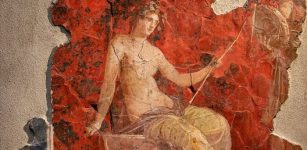 Never-Before-Seen Frescoes From Hadrian’s Time Unveiled At Ancient Roman Baths
Archaeology | Jun 27, 2022
Never-Before-Seen Frescoes From Hadrian’s Time Unveiled At Ancient Roman Baths
Archaeology | Jun 27, 2022 -
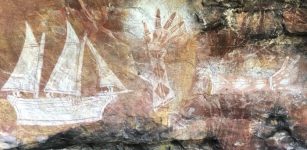 Map Of Hidden NT Landscape Where First Australians Lived More Than 60,000 Years Ago
Archaeology | May 5, 2023
Map Of Hidden NT Landscape Where First Australians Lived More Than 60,000 Years Ago
Archaeology | May 5, 2023 -
 Unique 1800-Year-Old Roman Coin Unearthed On Southern Carmel
Artifacts | Mar 1, 2021
Unique 1800-Year-Old Roman Coin Unearthed On Southern Carmel
Artifacts | Mar 1, 2021 -
 Arsinoe II Rose To Power Through Manipulations, Murder, Conspiracies And Became Worshiped As A Goddess
Featured Stories | Apr 26, 2019
Arsinoe II Rose To Power Through Manipulations, Murder, Conspiracies And Became Worshiped As A Goddess
Featured Stories | Apr 26, 2019 -
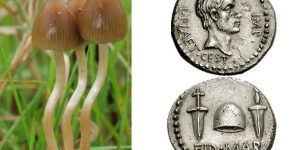 Strange Tale How The Liberty Cap Mushroom Got Its Name Starts In Ancient Rome
Featured Stories | Sep 3, 2023
Strange Tale How The Liberty Cap Mushroom Got Its Name Starts In Ancient Rome
Featured Stories | Sep 3, 2023 -
 Mythical Beautiful Adarna Bird And Its Harmful Magical Power In Mythology Of Philippines
Myths & Legends | Jan 25, 2017
Mythical Beautiful Adarna Bird And Its Harmful Magical Power In Mythology Of Philippines
Myths & Legends | Jan 25, 2017 -
 Mediterranean Hunter-Gatherers Relied On Marine Resources More Than Previously Thought
Archaeology | Feb 22, 2023
Mediterranean Hunter-Gatherers Relied On Marine Resources More Than Previously Thought
Archaeology | Feb 22, 2023 -
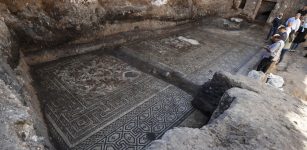 Rare Roman Mosaic Of Amazon Warriors Unearthed In Syria Hailed As Major Archaeological Discovery
Archaeology | Oct 12, 2022
Rare Roman Mosaic Of Amazon Warriors Unearthed In Syria Hailed As Major Archaeological Discovery
Archaeology | Oct 12, 2022 -
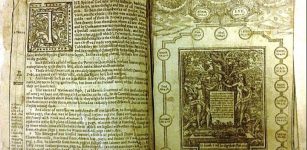 On This Day In History: The King James Bible Is Published For The First Time In London – On May 2, 1611
News | May 2, 2016
On This Day In History: The King James Bible Is Published For The First Time In London – On May 2, 1611
News | May 2, 2016

